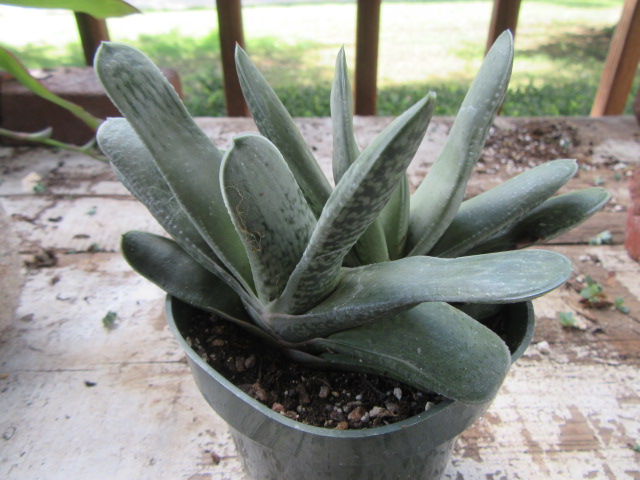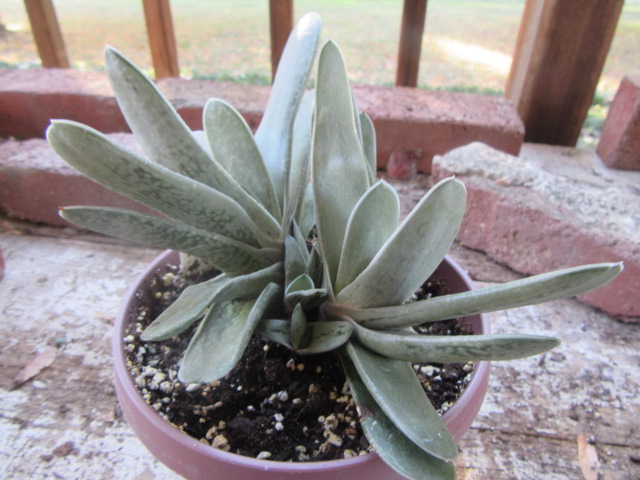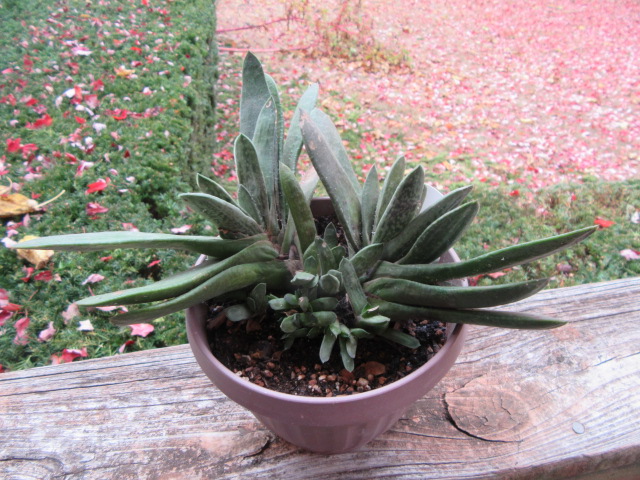
Gasteria species of some sort after I brought it home on 3-19-18. #3-19-18.
Ox Tongue, Cow Tongue, Lawyers Tongue
Gasteria sp. or Hybrid?
gas-TAIR-ee-uh
Gasteria Duval is the accepted scientific name for the genus. It was named and described by Henri August Duval in Plantae Succulentae in 1809.
As of 11-28-23 when this page was last updated, Plants of the World Online still lists 26 species in the Gasteria genus. It is a member of the plant family Asphodelaceae with 41 genera. Those numbers could change as updates are made on POWO.
THERE ARE A FEW LINKS AT THE BOTTOM OF THE PAGE FOR FURTHER READING.

Gasteria sp. on 3-21-18, #419-4.
I brought my first Gasteria home from Walmart on 3-19-18. It was unlabeled but at least I knew it was a Gasteria. I looked at hundreds of photos online to see if I could find out what species it was but I could find any like this one. I sent photos to a few people and posted them on a few Facebook groups to see if I could get an ID on the species. No one knew what specific species it could be but agreed it could be a hybrid. We will know more when it flowers… How long that will be is a very good question. 🙂
I try to buy only plants that are labeled unless I know what they are. Sometimes I have to buy the plants anyway…
A blog reader suggested this plant could be Gasteria ‘Smokey’, and it is a high possibility they are correct. Some photos online look like this plant.

Gasteria sp. with an offset starting to emerge on 3-21-18, #419-8.
There were two plants in the pot and a tiny offset starting to emerge. The two together measured about 2 3/4” tall x 3 3/4” wide in a 2 3/4” diameter x 2 1/4” tall pot. The pot is bulging somewhat and there are roots growing out of the bottom. All the cactus and succulents at Wal-Mart were soaking wet…

Gasteria sp. on 3-21-18, #419-7.
This was my first Gasteria and I was really surprised at the leaves. They are hard and feel like an old rubber tire. You know the kind, like a hard rubber tricycle tire. The leaves are very smooth and shiny but the edges are kind of a smooth rough feeling. GEEZ! Smooth and rough are kind of opposite words, huh? How about the surface of a closed zipper? Smooth but rough… 🙂
The leaves are distichous, especially on younger plants, which means they are arranged alternately in two opposite vertical rows. Now, mind you, that is not necessarily always true even within the species. If this is Gasteria bicolor or G. obliqua, whatever you want to call it, in the wild they normally produce plants that spiral or form some sort of a rosette. Umm… Except a group found north of the Zuurberg range which are distichous. Plants kept in pots are distichous.

Gasteria sp. roots coming out of the bottom on 3-21-18, #419-9.
The information I read said they are slow-growing and need shallow pots (although some information says they grow fast). It makes me wonder how old this plant may really be since there are roots coming out of the holes in the bottom of the pot… That curiosity won’t be solved until I have more experience and see how fast, or slow, they actually grow and learn more about their root system. Experience is the best teacher. 🙂

Gasteria sp. on 5-17-18, #443-33.
Once the temperatures warmed up, I moved all the potted plants outside for the summer. I put the Gasteria in a bigger pot.
The problem is figuring out the species or cultivar. I have looked at so many photos online it isn’t funny. None looked like the one I brought home. Daiv Freeman’s SucculentGuide has photos of 16 species and Llifle (Encyclopedia of Living Forms) has 24. Still, none look exactly like the one I brought home. I am beginning to think it could be a hybrid…

Gasteria sp. on 7-29-18, #487-43.
I moved the plant tables to the front porch on July 4 because of the Japanese Beetle invasion. They wrecked the whole environment where they had been before so I had to make a change.
The above photo was taken on 7-29-18 while making an update. The Gasteria is doing very well as far as I can tell.
One website says the most common species is Gasteria verrucosa which are covered with white warts. It says the Gasteria maculata is similar without warts. Well, Llifle says G. maculata is a synonym of Gasteria bicolor and Plants of the World Online says G. bicolor is a synonym of G. oblique (which Llifle says is a synonym of G. bicolor). OHHHH. This species is “variable”. That means if “we” are confused about not finding photos that look like “our” plants it’s OK. They are variable and who knows what they can look like… So, let’s go to Africa and see how many different variations we can find… The problem is, how many different species, that are similar, are growing in the same location? How do we know which is which if they are all “variable”? No wonder there are so many synonyms…
Even though mine has smooth leaves so the warty species are not in the running, Plants of the World Online says Gasteria verrucosa is a synonym of G. carinata var. verrucosa. That time Llifle is in agreement. That is just some information if you have a warty Gasteria verrucosa. You know it isn’t the correct name now. 🙂 Some day multiple scientific names for the same plants will be history.
USEFUL INFORMATION:
Family: Asphodelaceae
Origin: South Africa
Zones: USDA Zones 11, possibly 10a (30-40° F)
Size: Ummm…
Light: Light to part shade.
Soil: Fast-draining soil. Potting soil amended with pumice or additional perlite and chicken grit.
Water: Average water needs but information suggests soil shouldn’t dry out and to water during the winter when soil is dry.
Hmmm…. This plant is from South Africa and they are saying the soil shouldn’t dry out. This is interesting about Gasteria as many species grow in areas with heavy summer rainfall.
You can read my Cactus Talk & Update and Cactus & Succulent Tips to get my opinion about growing cactus and succulents.
UNIQUE FLOWERS, TOO!
Besides the strange leaves, the flowers are also very unique to Gasteria species. They have stomachs! That’s where the genus name comes from. “Gaster” is Latin for “stomach”. The basil portion of the flowers are “inflated” or “swollen” which gave rise to one common name, Lawyers Tongue. I can hardly wait until this plant flowers so I can post photos… They can flower any time of the year but mainly during the winter…
If I were to halfway guess, I would probably have to say it is Gasteria bicolor or G. oblique, which are the same since they are synonyms of each other (or one another) depending on what database you look at. Some even say both species are accepted. Plus since it, or they, are variable as far as color is concerned. Light green and dark green, streaked and spotted… All on the same plant. One thing for sure is the leaves are smooth without warts… You also have to take into consideration what is available in quantity. It is unlikely that a supplier to Walmart would have rare or hard-to-propagate species. That certainly narrows down the choices.
The Llifle website says this about the leaves of Gasteria bicolor, (which is a synonym of Gasteria obliqua according to POWO): “smooth or (rarely) slightly asperulous, shiny dark green or glaucous green, with no spots except a few on the back towards the base or heavily mottled with cream spots arranged in obscure transverse lines.”

Gasteria sp. on 10-10-18, #519-35.
I had to move the potted plants inside for the winter on October 10 because there was a chance of an “F” in the forecast. I always measure the cactus and some of the succulents when I move them inside. The Gasterias (since there are two in the pot) measured 3″ tall x 5 1/4″ wide. The two plants are pretty much the same size. They measured 2 3/4″ tall x 3 3/4″ wide when I brought this pot home on 3-19-18.
<<<<2019>>>>

Gasteria sp./Hybrid ? on 5-5-19, #566-26.
This Gasteria made it through the winter with no issues and all the potted plants were glad to get back outside in the fresh air in May. You have to make sure all danger of “F” has passed.

Gasteria sp/Hybrid ? on 5-5-19, #572-2.
When putting your Gasteria outside, it is always a good idea to put them where they would do well in nature. In the wild, Gasteria prefers light shade to shade. They grow in shallow soil in the shade of other plants. They will tolerate sun for short periods during the day so being on the front porch has been an ideal place for it. The front porch faces west and there are two maple trees that shade it later in the afternoon. If given more sun the leaves may take on a reddish tint and grow more compact.

Gasteria sp/Hybrid ? on 5-5-19, #572-3.
As these two plants have grown, I noticed their older leaves are slightly but smoothly bumpy.

Gasteria sp./Hybrid ? on 5-15-19, #572-5.
Gasteria species grow in summer rainfall regions in Africa. They aren’t all that particular about their soil as long as it drains very well. I have started using a 50/50 mixture of good potting soil, such as Miracle Grow Potting Soil, with pumice I ordered online from General Pumice. I had been using 2 parts Miracle Grow or Schultz Potting Soil with 1 part chicken grit and 1 part perlite. Pumice replaces both plus it adds nutrients as you water. Pumice doesn’t float to the top of potting soil like perlite does. I usually give them regular watering during the summer when their soil is dry but barely during the winter. Some information says their soil should be moist during the summer, but not wet, and water during the winter when the soil dries out.

Gasteria sp./Hybrid ? on 6-16-19, #591-18.
Gasteria species are supposedly summer dormant which means they do most of their growing in the spring and autumn (like winter dormant species do). They supposedly go dormant during the hotter months somewhere between May through August. That is weird to me because they grow in summer rainfall regions in Africa. Hmmm… Anyway, that is what the experts say.

Gasteria sp./ Hybrid ? at 3 7/8″ tall x 6 1/2″ wide on 10-11-19, #639-35.
Once again an “F” was in the forecast so I had to move the potted plants inside for the winter. This time, this Gasteria had grown to 3 7/8″ tall, and the two together measured 6 1/2″ wide. That’s pretty good!

Gasteria sp/Hybrid ? on 10-11-19, #639-36.
I sent a message to one of the foremost Aloe hybridizers in November to get his opinion about what species or cultivar it could be. He agreed that it could be a hybrid and had this to say:
“I don’t see it as a species but it does look a little bicolorish. (I assume by saying “bicolorish” he meant Gasteria bicolor, which is a synonym of G. obliqua). We found pillansii in the wild with this milky leaf color. I would suggest it is a hybrid but certainly, without a flower, it is difficult to determine provenance or even narrow it down. Many growers sell both species and hybrids. It very could well be from our nursery as we supply plants for Wal-Mart and HD and Lowe’s.”

Gasteria sp./hybrid roots on 11-13-19, #649-9.
I decided to repot several cacti and succulents after I brought them inside for the winter. I think fall is a good time so their soil will be nice and loose for the winter. When I removed the Gasteria from the pot I noticed something weird…

Gasteria sp./hybrid roots on 11-13-19, #649-10.
At first glance, I thought they were ant eggs but there were no ants present. Almost every year there is at least one pot where ants have moved into and come into the house. That hasn’t happened since I moved the plant tables on the front and back porch. Anyway, this is mycelium among the plant roots which is a “friendly” fungus. I just have never seen this before in pots.

Gasteria sp./hybrid in its new pot on 11-13-19, #649-11.
Now the Gasteria with no ID is in another new pot. I loosened the roots a bit but I left the bacteria alone to see what happens.

Gasteria sp./hybrid with new offset on 11-13-19, #649-12.
While repotting I noticed a new offset. It had one when I brought it home but it disappeared…
<<<<2020>>>>

Gasteria sp. at 4 3/4″ tall x 6 3/4″ wide on 10-15-20, #747-39.
I had to bring my plants inside for the winter on October 15 in 2020 because an “F” was in the forecast. As always I took photographs and measurements. The largest plant in the pot measured 4 3/4″ tall x 6 3/4″ wide and there are SEVEN offsets! It had done well!
<<<<2021>>>>

Gasteria sp./hybrid ? at 5 1/2″ tall on 8-17-21.
The Gasteria sp./hybrid ? is continuing to do very well. The largest plant was 6″ tall when I measured it on August 17 in 2021 when I took the above photo. It is still 6 3/4″ wide and there were 9 offsets in the pot.
<<<<2022>>>>

Gasteria sp. ? at 5 1/4″ tall x 7 1/8″ wide on 10-16-22. #919-16.
The Gasteria sp. ? is doing much better now and was 5 1/4″ tall x 7 1/8″ wide when I moved the potted plants in for the winter on October 16 in 2022. We had a little battle with mealybugs over the previous winter and it wasn’t looking so great when I moved the plants outside. Luckily, it survived. For the winter, it will be with plants that aren’t susceptible to mealy bugs and I will keep an eye on it.
<<<<2023>>>>

Gasteria sp. ? on 10-24-23, #968-12.
The Gasteria ? still had an issue with mealy bugs last winter but not as bad as the previous winter. It was showing signs of issues to come, but hopefully, we can handle it. Some of the surface near the base of the leaves is showing a slight stickiness but I didn’t see any mealy bugs. It did very well over the summer on the front porch, still somewhat isolated and with plants that aren’t susceptible to mealy bugs.
I really like this plant whether it is a species, cultivar, or hybrid. The only thing I am sure about is that it is definitely a Gasteria.
I will continue adding more photos and information as time goes by.
The article by Geoff Stein (palmbob) on Dave’s Garden (see link below) is very interesting and useful. I have also corresponded with him in the past about my Aloe maculata (which is also “variable”).
I hope you enjoyed this page and maybe found it useful. If you have any comments, questions, or suggestions, I would like to hear from you. Please click on “like” if you visited this page. It helps us bloggers stay motivated. 🙂 You can check out the links below for further reading. The links take you directly to the genus and species of this plant.
Same problem with naming here,,,have “Cow Tongue”…rough, all green,,,sharp point,,,,wonder which Gasteria it is????
LikeLiked by 1 person
Hello Karen! Hmmm… Good question. You can send a photo to me at thebelmontrooster@yahoo.com and I will see if I can help. There are also several Facebook groups that help with ID. You can join groups and then post your photo. Or, if you send me a few photos I can post if for you. Thanks for the comment and thanks for visiting.
LikeLike
I think it could be gasteria cv. Smokey
LikeLiked by 1 person
Hello there! Thanks for the suggestion! I checked it out online and you could be right. Take care and thanks for the comment!
LikeLike